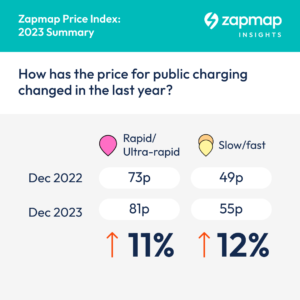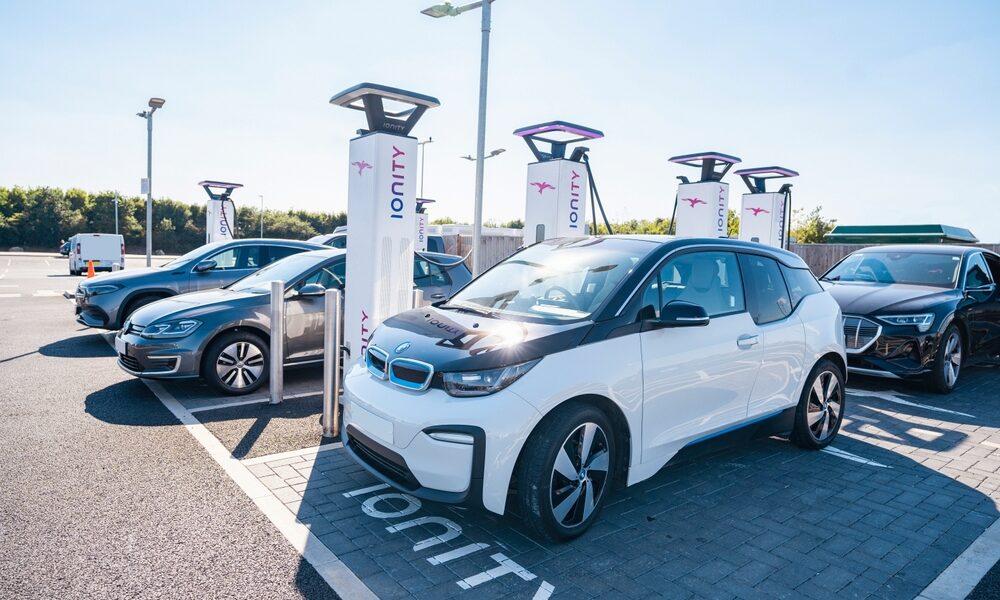Public EV charging costs jump 11% in 12 months
The cost of using the UK’s public charging network has risen by more than 10% in the last year, according to new data.
Analysis of data from the Zapmap Price Index show that the overall average cost of using public chargers increased by 11% between January 2023 and January 2024, with prices for slow/fast devices rising slightly more than rapid and ultra-rapid charging.
Drivers now pay an average of 81p/kWh for rapid and ultra-rapid charging, and 55p/kWh for slow and fast charging. Despite the shift, Zapmap estimates that most EV drivers are still paying less per mile than a motorist in an equivalent petrol-powered vehicle.
Zapmap’s experts say that part of the reason for the increase was a consolidation of prices among ultra-rapid charging providers. While some operators maintained their prices last year, others significantly increased theirs to bring them in line with their rivals’. According to Zapmap, the top six providers have now settled at 79p/kWh, while Instavolt charges 85p/kWh.
The data also shows that drivers are increasingly turning to ultra-rapid chargers on the public network. Device numbers grew 112% in 2023 but ultra-rapid sessions rose 150% over the same period and in December 2023 accounted for 45% of all energy delivered.

Zapmap COO, Melaine Shufflebotham, said that economic uncertainty and cost pressures on charging networks had also contributed to higher costs and meant a drop in prices was unlikely in the near future. Operators have been hit by a change to the grid code that means they now face standing charges that are, in some cases, 10 times what they were two years ago.
Shufflebotham said: “With the continued uncertainty in wholesale energy prices and other cost pressures, don’t expect prices on the public charging network to come down in the near future.
“However, looking to the future, there are reasons to be positive. There is continued pressure on the government to equalise the VAT levels between domestic and public charging at 5%. FairCharge is campaigning hard on this and the recent recommendations from the House of Lords also state that the government should act on this.
“In addition, the industry is working both to look at the standing charges and to see if they can get electricity within the government’s Renewable Transport Fuel Obligation.
“In the here and now, most electric car drivers continue to experience lower costs than driving an equivalent petrol or diesel car.”
Huge savings over ICE
EV drivers who charge mostly at home on an EV-specific tariff could be saving almost £800 a year compared with a petrol or diesel driver, according to Zapmap’s calculations. Based on an average tariff of 8.5p/kWh, someone who charges at home 80% of the time and uses rapid chargers the rest of the time will pay just 7p per mile while an ICE driver will pay 15p per mile.
Even those who only charge at home half the time and use a mix of fast and rapid chargers elsewhere will pay just 11p a mile.
However, reinforcing the need for a cut in VAT on public charging, the data shows that those without access to home charging are still struggling. For someone using slow or fast public charging 80% of the time – for instance at kerbside devices – and rapid charging the other 20%, the per-mile cost is 18p.
Jade Edwards, head of insights at Zapmap, said: “We know that 2023 was a very good year for EV charging, with record growth across the board and especially good progress for ultra-rapid infrastructure in the UK.
“So it’s really interesting to see from these figures how EV charging prices changed last year, in line with the more than 100% growth in ultra-rapid devices being installed across the country.
“Although 2023 saw some charge point operators increase their prices to move more in line with the market, the changing mix of public charging options and the shift in use from rapid to ultra-rapid devices is also a contributing factor. This is particularly significant because we know that electric car drivers were less likely to seek out a cheaper alternative to refuel than when driving a petrol or diesel car.”
A Zapmap survey found that just 10% of EV drivers said they “always” sought out the cheapest charging points, compared with 20% of ICE drivers who seek out cheaper fuel. And 29% of EV owners said they never actively looked for the cheapest charging locations. Despite this. 62% said that the cost of public charging was a problem – up from 41% in 2022.






